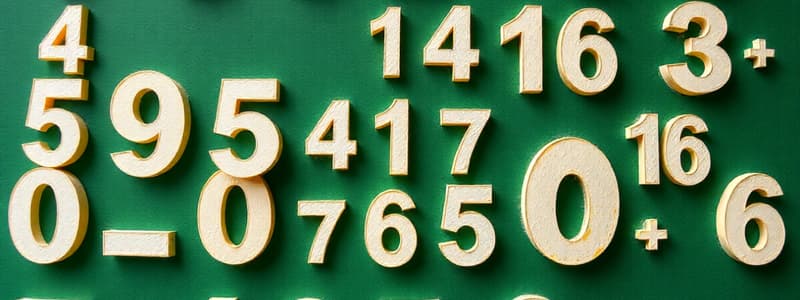Podcast
Questions and Answers
Which property of addition is demonstrated by the equation $9 + 0 = 9$?
Which property of addition is demonstrated by the equation $9 + 0 = 9$?
- Commutative Property
- Identity Property (correct)
- Distributive Property
- Associative Property
According to the associative property of addition, the order in which numbers are added affects the final sum.
According to the associative property of addition, the order in which numbers are added affects the final sum.
False (B)
What is the sum of -15 and 8?
What is the sum of -15 and 8?
-7
In the context of addition, the numbers being added together are called ______.
In the context of addition, the numbers being added together are called ______.
What is the first step in adding two fractions that have different denominators?
What is the first step in adding two fractions that have different denominators?
Which of the following equations demonstrates the commutative property of addition?
Which of the following equations demonstrates the commutative property of addition?
Evaluate: $\frac{2}{5} + \frac{1}{3}$
Evaluate: $\frac{2}{5} + \frac{1}{3}$
Match the following properties of addition with their descriptions:
Match the following properties of addition with their descriptions:
What is the result of adding $5.25 + 3.8$?
What is the result of adding $5.25 + 3.8$?
Which of the following expressions correctly combines like terms in $(7a + 4b) + (2a - b)$?
Which of the following expressions correctly combines like terms in $(7a + 4b) + (2a - b)$?
In column addition, you should start adding from the leftmost column.
In column addition, you should start adding from the leftmost column.
Using the breaking apart method, what are the intermediate steps to calculate $37 + 56$?
Using the breaking apart method, what are the intermediate steps to calculate $37 + 56$?
Using the compensation method, $59 + 34$ can be rewritten as ______ + 33.
Using the compensation method, $59 + 34$ can be rewritten as ______ + 33.
In which of the following real-world scenarios is addition LEAST likely to be used directly?
In which of the following real-world scenarios is addition LEAST likely to be used directly?
Match the addition technique with its description:
Match the addition technique with its description:
Given two algebraic expressions: $4x^2 + 2y - 3$ and $x^2 - y + 5$. What is their sum?
Given two algebraic expressions: $4x^2 + 2y - 3$ and $x^2 - y + 5$. What is their sum?
Flashcards
What is addition?
What is addition?
Combining numbers to find their total.
Commutative Property
Commutative Property
The order of numbers doesn't change the sum.
Associative Property
Associative Property
The grouping of numbers doesn't change the sum.
Identity Property of Addition
Identity Property of Addition
Signup and view all the flashcards
What are Integers?
What are Integers?
Signup and view all the flashcards
Adding integers with the same sign
Adding integers with the same sign
Signup and view all the flashcards
What are Fractions?
What are Fractions?
Signup and view all the flashcards
Adding fractions: first step
Adding fractions: first step
Signup and view all the flashcards
Adding Decimals
Adding Decimals
Signup and view all the flashcards
Adding Algebraic Expressions
Adding Algebraic Expressions
Signup and view all the flashcards
Column Addition
Column Addition
Signup and view all the flashcards
Breaking Numbers Apart
Breaking Numbers Apart
Signup and view all the flashcards
Rounding and Adjusting
Rounding and Adjusting
Signup and view all the flashcards
Compensation (Addition)
Compensation (Addition)
Signup and view all the flashcards
Addition in Everyday Life
Addition in Everyday Life
Signup and view all the flashcards
Addition in Finance
Addition in Finance
Signup and view all the flashcards
Study Notes
No new content to add. Study notes are up to date.
Studying That Suits You
Use AI to generate personalized quizzes and flashcards to suit your learning preferences.



